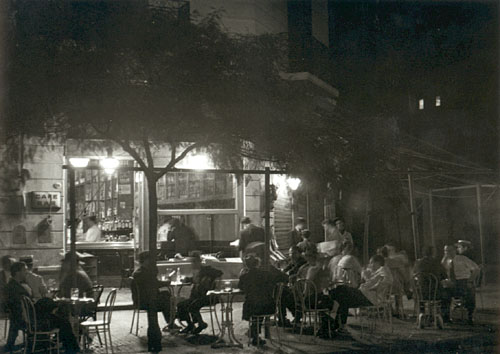Cartographies
by Horacio Castellanos Moya / September 27, 2012 / No comments
In memoriam of bars past

Photo: Horacio Coppola, Rivadavia y Misiones, 1936. Wikimedia Comons.
The lives of certain writers can be followed, as one follows a precise route on a map, through the bars in which they’ve passed their nights, or part of them. Something similar also happens with journalists—but only with those of the old school, not with the yuppies today who neither drink nor smoke, and drink decaffeinated coffee. “Tell me in what bar you live part of your days and I’ll tell you who you are,” says the proverb.

- Corkscrew is focused on Latin American issues. Literature, journalism and politics are the main concerns of this column. A corkscrew is useful only if it opens a bottle, hopefully full of something that would
enlighten our spirits, but we could also set loose a cruel Genie or a rotten wine. The author will follow this principle: look for topics that open debates, new perspectives, and controversy. Cheers! 
- Horacio Castellanos Moya is a writer and a journalist from El Salvador. For two decades he worked as a journalist in Mexico, Guatemala, and his own country. He has published ten novels, five short story collections and two books of essays. He was granted residencies in a program supported by the Frankfurt International Book Fair (2004-2006) and at City of Asylum/Pittsburgh (2006-2008). In 2009, he was a guest researcher at the University of Tokyo. Currently he teaches at the University of Iowa.
I belong to that first category of writer, and was also a journalist of the old school. Sometimes, when I get nostalgic, I like to go back over that personal cartography in my memory. When I do, I discover that it begins in Mexico City, on Avenue Insurgentes Centro, in a cantina called La Castellana, that for me even served, on some occasions, as an alternate office at lunch time, when the murmur of conspiracies was drowned out by the racket of the other customers. From there I can reconstruct, cantina by cantina, the different neighborhoods in which I lived and the different newspapers and magazines where I worked for over a decade in that city.
And so, in every city where I’ve rested my bones, I’ve almost always encountered a beloved bar, sometimes nearby, sometimes not, that becomes the place where I soak up the city and its inhabitants—a bar where I not only drink, but also drink in the atmosphere, a way of being and of understanding the world: El Portalito in Guatemala City, La Luna in San Salvador, the Tirso de Molina at the entrance to Lavapiés in Madrid, the Metropol behind the Frankfurt Cathedral, Hemingway’s in Pittsburgh, the Buchi in the foothills of Shibuya. And now, in this small city in the American midwest where I pass my days, I have spent time in a couple of legendary bars: the Fox Head and George’s, located barely fifty meters apart, where young men and women anxious to become successful writers swarm.
More than once I’ve asked myself what type of writer I might have been, what type of works I might have written, if I hadn’t spent so many hours of my life in a bar, squandering my vital energy and saturating my senses. The question is stupid, I know, because I wouldn’t be me. If writing fiction required the mentality of an ayatollah or a businessman, I would have dedicated myself to a different occupation.
But I come back to this personal cartography, I was saying, when I get nostalgic, like now, when autumn rocks us back and forth with premonitions, when the misfortune that has attacked loved ones makes me remember that death comes without warning, and that from this life we will take nothing with us, not even those beautiful memories of bars where time takes on a different texture, where what we are is nourished by braggadocio, seduction, and enthusiasm.
Translation: Sam Cogdell




